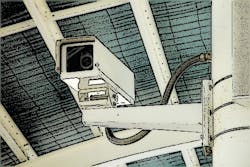As security technology continues to evolve, end-users are demanding high-resolution video that is detailed enough to be used in investigations and courts of law. However, this type of video quality comes at a premium, even as security budgets remain tight. Fortunately, as video capabilities continue to advance; edge-based surveillance has emerged to bridge the gap between limited funds and the need for high-resolution video.
Traditionally, network video surveillance has operated using a centralized approach: Each camera's video feed is sent over the network to be processed by a central DVR, NVR, computer or network server using video management software. With the majority of users moving from analog to IP cameras, the centralized structure is requiring more network bandwidth and computer processing power than ever before. When high-resolution technology is used, the centralized approach can quickly lead to a cost-prohibitive system.
Higher-resolution video puts greater demands on both the network and the central server. The more cameras added, the greater the bottleneck, which slows down the entire network and forces users to spend even more money on additional servers. In addition, bandwidth limitations often force enterprises to compress video data from high-resolution cameras. Compression makes transferring and storing video easier, however, the resulting video is not ideal for investigations or forensic purposes.
In contrast to the centralized approach, edge-based security pushes video intelligence to the network's edge, which has a profound effect on the cost, functionality and maintenance requirements of a surveillance system. To record video at the edge, a decentralized surveillance system incorporates a high-speed computer and memory card into the camera. The PC and video control center are used to view and manage video, rather than to analyze and record it.
This edge-based approach has become increasingly attractive as more users move from traditional analog systems to digital technology for greater accuracy, more detailed images and more intuitive capabilities. Consider that a 3-megapixel camera can record approximately 30 times more detail and, when compared to an analog camera, is able to provide a complete view of a much larger area. Without edge-based technology, high-resolution cameras would require more network bandwidth and robust processing power from the PC, especially when several cameras are used together. Not surprisingly, such a system quickly becomes expensive.
Edge-based surveillance solves the bottleneck problem by using the camera to decentralize intelligence and video data. The result is sustainable high-resolution surveillance, combined with in-camera processing and recording. High-resolution video data is saved either remotely on the network or locally on flash memory devices such as SD cards or USB memory. For many businesses, storage at the edge is sufficient. For example, a 64 GB MicroSD card would provide a gas station with complete high-resolution surveillance coverage for up to eight days at 1 frame per second. However, if more storage is needed, or as the network grows, network attached storage can be added at relatively low cost. Storage requirements can be further reduced using event-trigger features in many edge-based cameras. For example, recording would only occur in these cameras when an event, such as a motion or noise detection sensor is triggered.
Some users may see even more cost and time savings with an edge-based system, depending on the size, nature and specific surveillance needs of their application. This approach is often attractive to budget-conscious customers, such as retail and government. Edge-based surveillance reduces many immediate and long-term costs because self-managing, expensive central recording systems are no longer required. Costs are further reduced due to the scalability of the system: As more cameras are added, only more storage is needed. No recording software licenses are required. As a result, end-users can save thousands of dollars in a single installation. At the same time, installers and integrators save on upfront and long-term costs, enabling them to achieve ROI more quickly.
Another benefit of an edge-based system is less costly maintenance. With no server maintenance, no complex proprietary hardware and software, and no storage or scaling limitations, edge-based technology provides a simplified solution that requires relatively little ongoing maintenance.
Gone are the days of thousands of analog cameras needed to secure a single business. Now, one camera can intelligently master multiple roles, including the viewing, recording and storing of images. Users can still simultaneously accomplish everything they need — such as live video transfer, recording and event search. Overall, a decentralized approach is more cost- effective, provides more value to the end- user and is easier to scale than traditional systems.
Edge-based surveillance solutions also give installers and integrators a chance to differentiate themselves from the competition. They are empowered to provide users with a decentralized system that is capable of truly solving the core problems commonly associated with high-resolution video. Costs are substantially reduced because high-resolution, decentralized surveillance systems require fewer cameras and storage devices and, in the end, less hardware.
About the Author

Steve Gorski
Security Consultant
Steve Gorski has extensive experience in senior management positions in the security and parking industries, spanning over 23 years. He played a pivotal role in advancing IP surveillance technology in the security industry and has been actively involved in the technological transformation of the parking industry for the past 6+ years. Steve has held prominent positions in top companies like Axis Communications, MOBOTIX, and DESIGNA. You can reach Steve at [email protected] or 617.599.2571.
